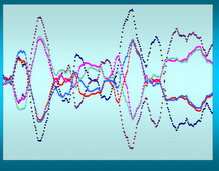But what caught my attention was one of the lines in this filter -
EMA(140) has been increasing for the last 5 days
I had never worked with the EMA 140 before and when I put it on a long term chart along with the MA 200 I saw right away that EMA 140 conforms to daily values much better than the MA 200. MA 200 is an antiquated concept and absolutely no one knows why it was ever used but it just hangs on and hangs on. Well I'll explain it to you and you will then know more than 99% of all the traders in the world - the value "200" was selected for the simple fact that it describes one year of trading. There are 200 trading days in the normal year (52 weeks times 5 = 210 - 10 bank holidays = 200). In leap year you get 201 of course but no one feels compelled to make that adjustment. And MA 200 made sense back in the old "buy and hold" forever days of playing the market because if your stock or stocks were dipping below the MA 200 there were deep problems with it and you wanted out.
But the EMA 140 makes better sense today because it absolutely describes the support/resistance of a stock's daily pricing. Here is a picture with the EMA 140 and the MA 200 -

(Edit - this is an update of the original where I had the EMA 120 vice 140.)
It is easy to see how the EMA 140 "belongs" with the stock where the MA 200 is aloof and disconnected. My take is simple - I'm putting EMA 140 on my charts when appropriate (daily values) and I think we can put the MA 200 to rest at last.
And as an oh by the way - I don't normally recommend "cheap stocks" but this one, ALTH, might be going places (at least another 50 cents to a buck). Here is the pivot point chart -

These drug manufacturers are always difficult to buy but it seems to be holding a line here and the pivot point suggests that it might try to break out so who knows - it might get a buck in the next month or so.
So here's Shay's filter - as I said I like it for its long term potential - I'll have to examine On-balance volume and see what makes it tick. Thanks Shay -
show stocks where ema(140) has been increasing for the last 5 days
and ma(33) has been increasing for the last 5 days
and close is between 20 and 0.7
and average volume(10) > 20000
and ema(20) is above ma(33)
and add column Market
and obv(1) reached a new 6 months high
and volume > 20000
and add column average volume(10)
and sort column 6 ascending

8 comments:
Just curious if you tested it with higher volume required. I hate those tiny volume stocks. If not I'll tinker with it this morning and see if volume makes a difference.
@ Bullish Jim
I tested it with higher volume stocks and it acts fine.
Use Marlyn's criteria, i.e. stock price 15-35$ and average volume(90) > 500000.
The tiny stocks just give better bang for the buck.
Thanks, s. That's very helpful.
Your chart of ALTH is showing EMA120 not EMA140. Guess that's what ya get for posting at 6:48 a.m. Good grief man, get some sleep! :)
Thanks - I fixed it. Same difference just a little further away - maybe 120 is better???
120 seemed to be tracking pretty well!
52 weeks * 5 trading days = 260 - 9 market holidays = 251. Not 200.
Interesting post on EMA.
Post a Comment